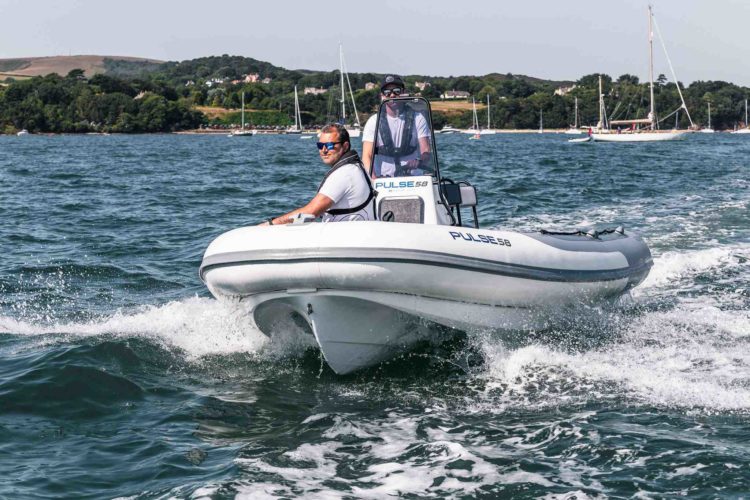

Sailing into a More Sustainable Future
Quieter, less-polluting electric boats are gaining ground in the marine marketplace, but there’s a problem. Most manufacturers produce these craft by installing electric packages on existing boat models. “Those boats are hugely compromised because they are not designed for electric use,” says Alex Newton-Southon, CEO – Design & Technologies at RS Sailing, a sailboat manufacturer based in the United Kingdom.
RS is changing that. In January 2020, its sister company, RS Electric Boats, introduced the Pulse58, a rigid inflatable boat (RIB) manufactured from composite materials and designed for electric power and for sustainability. “We wanted to make sure that the way we made the boat would be as green as we could possibly do commercially,” says Newton-Southon. “Hence, we are very keen to make sure our production methods are as sustainable as they can be.”
Work on the Pulse58, which measures 19.1 feet long and 8 feet across the beam, began about two-and-a-half years ago. The challenge was to build a hydrodynamically efficient craft capable of carrying the weight of passengers and equipment. “With electric power, to have the speed that we want and to make sure that the power in the boat is as useful as we can make it, we need to be chasing all sorts of efficiency, both hydrodynamically and in weight,” says Newton-Southon.
A cathedral-style hull provided the solution. “It’s still very much a monohull, but it has the supports on the outside to allow it be as slender as possible to increase the waterline length and to reduce any drag,” he adds.
To reduce design time and take advantage of existing, proven technology, RS used the battery pack, the charging system and some motor controller parts from Nissan’s LEAF electric vehicle in the Pulse58. The design places the batteries low in the boat, resting on the hull’s skin. That reduces the pitching of the boat and uses the water along the hull to cool the batteries and dissipate the heat.
In designing the Pulse58, RS replaced the traditional propeller engine with a rim propulsion system from RAD Propulsion. Instead of being mounted on a central hub, the propellers are attached to the rim of the motor. This system is more efficient than traditional propeller drivers at the Pulse58’s maximum speeds of approximately 20 knots. Another advantage to the rim system is that any debris, like fishing line, flows through the open center rather than getting caught in the propeller.
Composites manufacturer NORCO worked with RS to select and test sustainable composite materials, such as bioresins, for the Pulse58’s manufacture. “We teamed with Wessex Resins and sampled some of their resins to make sure that they worked with the material that we were going to use,” says Simon Mitchell, NORCO’s production manager. The plant-based resin formulations, which contain organic content like vegetable waste, reduce the production of greenhouse gases by about one-third.
The bioresins can be incorporated into the composite materials without requiring any changes in NORCO’s vacuum infusion manufacturing process. “It’s got good viscosity, very good UV stability, cures the same as a vinyl ester or epoxy infusion resin and still has the same hardness and tensile strength,” says Mitchell.
NORCO has been using flax fibers and is also testing basalt fibers for the Pulse58’s body. The strong, naturally fire-resistant basalt fibers are made from igneous rock that has been crushed, melted and then extruded. One benefit of basalt fiber is that it can be recycled back into its original form.
NORCO is manufacturing the boat’s hull, deck, console seating and battery box through a vacuum infusion process that will take about four days. NORCO will then bond the parts together and ship them to RS Electric, which is located about 38 miles away, for final manufacturing. The proximity of the composites manufacturing plant to RS’s boat production facility will reduce greenhouse gases generated by transporting the composite parts.
RS is using a sustainability life cycle assessment tool to ensure that its materials and manufacturing processes have the smallest possible carbon footprint. To offset any remaining carbon dioxide production and ensure the build cycle is carbon neutral, the company is planting trees in Africa through the non-profit organization TREE AID.
RS Electric introduced the Pulse58 at the Dusseldorf Boat Show in January 2020 and already has multiple orders. The cost of the boat is approximately $116,000, which includes a 30% to 35% premium due to the sustainability of its materials.
The company is still building and testing prototypes, but actual production should begin in March 2021. RS anticipates manufacturing approximately 100 Pulse58s each year. Although the company originally thought its primary market would be sailing schools and institutions, it is generating interest from other areas, such as police departments and super yacht owners.
Even when production begins, Newton-Southon says that the design of the Pulse58 will constantly evolve to take advantage of new ideas and materials that come along. “We are planning to do a range of electric boats, and as things develop, we want to reduce the carbon footprint as much as we can,” he explains.
Sustainable composites are key to this continuing journey of improvement, and Newton-Southon says the company is happy to share what it is learning, even with other boat builders, to encourage the further development and production of these materials. “To make this really work there needs to be a demand,” he says. “If everyone got involved in doing this, it would be fantastic.”

SUBSCRIBE TO CM MAGAZINE
Composites Manufacturing Magazine is the official publication of the American Composites Manufacturers Association. Subscribe to get a free annual subscription to Composites Manufacturing Magazine and receive composites industry insights you can’t get anywhere else.



